1999 SUBARU LEGACY wheel torque
[x] Cancel search: wheel torquePage 923 of 1456
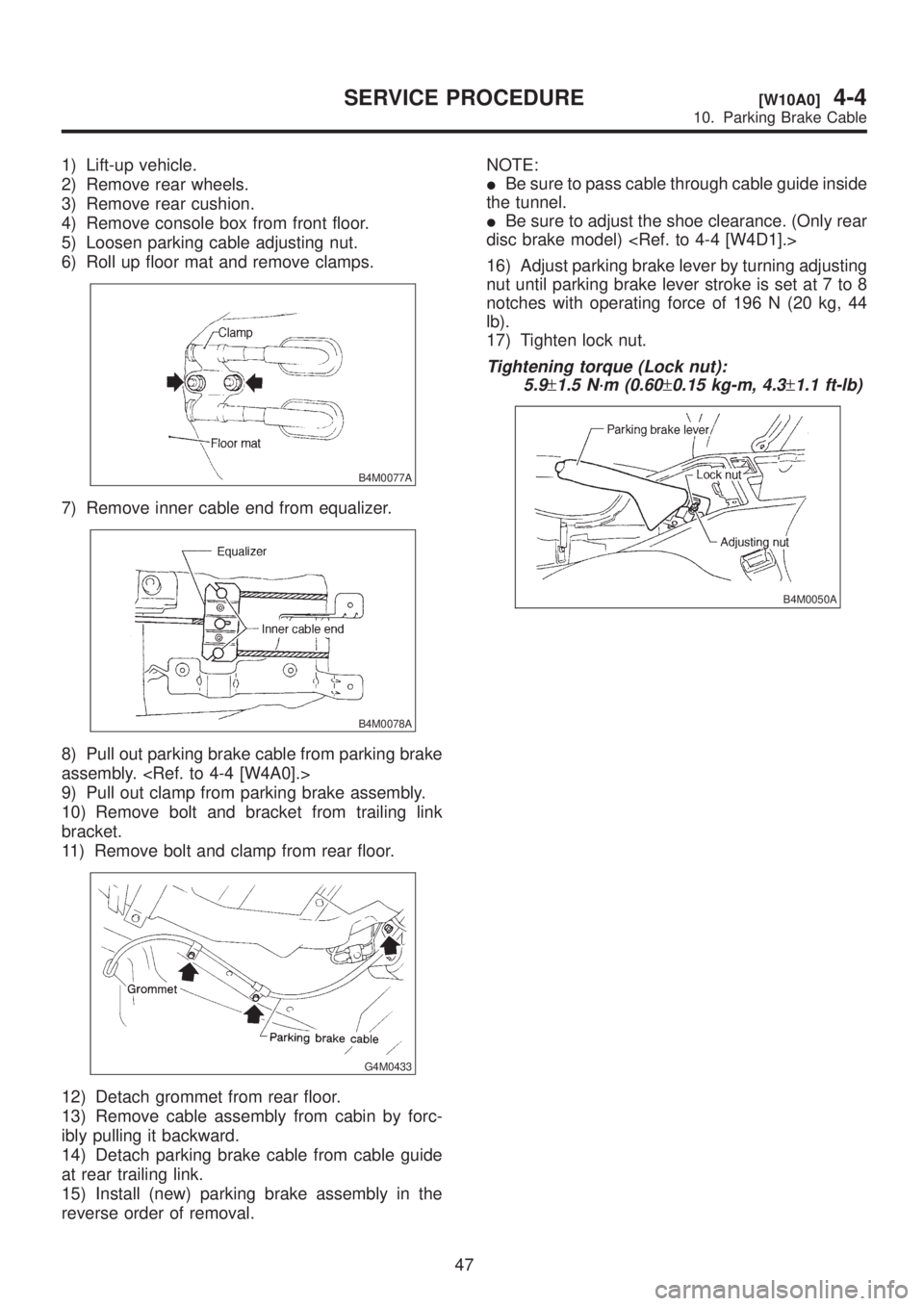
1) Lift-up vehicle.
2) Remove rear wheels.
3) Remove rear cushion.
4) Remove console box from front floor.
5) Loosen parking cable adjusting nut.
6) Roll up floor mat and remove clamps.
B4M0077A
7) Remove inner cable end from equalizer.
B4M0078A
8) Pull out parking brake cable from parking brake
assembly.
9) Pull out clamp from parking brake assembly.
10) Remove bolt and bracket from trailing link
bracket.
11) Remove bolt and clamp from rear floor.
G4M0433
12) Detach grommet from rear floor.
13) Remove cable assembly from cabin by forc-
ibly pulling it backward.
14) Detach parking brake cable from cable guide
at rear trailing link.
15) Install (new) parking brake assembly in the
reverse order of removal.NOTE:
IBe sure to pass cable through cable guide inside
the tunnel.
IBe sure to adjust the shoe clearance. (Only rear
disc brake model)
16) Adjust parking brake lever by turning adjusting
nut until parking brake lever stroke is set at 7 to 8
notches with operating force of 196 N (20 kg, 44
lb).
17) Tighten lock nut.
Tightening torque (Lock nut):
5.9
±1.5 N´m (0.60±0.15 kg-m, 4.3±1.1 ft-lb)
B4M0050A
47
[W10A0]4-4SERVICE PROCEDURE
10. Parking Brake Cable
Page 924 of 1456
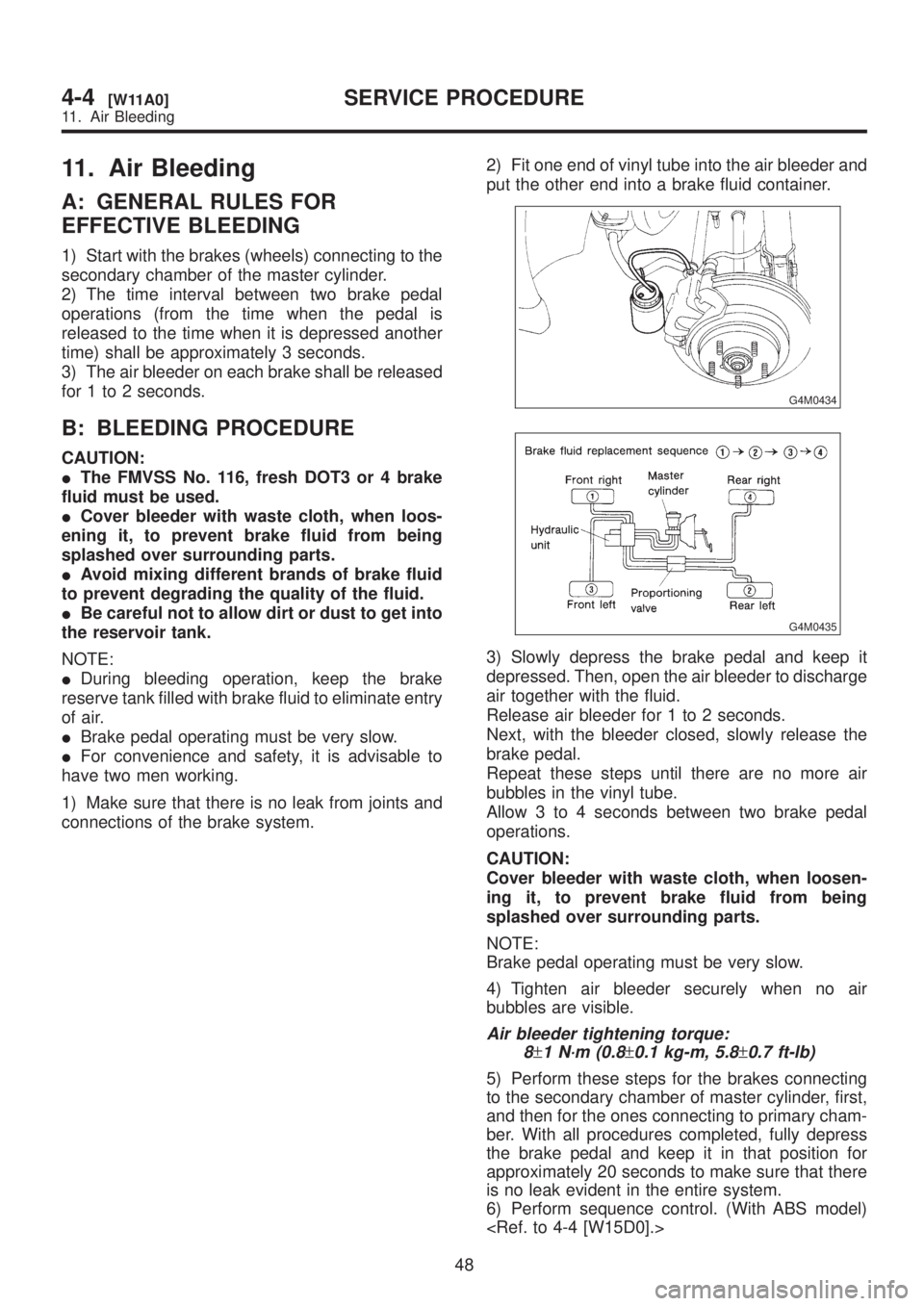
11. Air Bleeding
A: GENERAL RULES FOR
EFFECTIVE BLEEDING
1) Start with the brakes (wheels) connecting to the
secondary chamber of the master cylinder.
2) The time interval between two brake pedal
operations (from the time when the pedal is
released to the time when it is depressed another
time) shall be approximately 3 seconds.
3) The air bleeder on each brake shall be released
for 1 to 2 seconds.
B: BLEEDING PROCEDURE
CAUTION:
IThe FMVSS No. 116, fresh DOT3 or 4 brake
fluid must be used.
ICover bleeder with waste cloth, when loos-
ening it, to prevent brake fluid from being
splashed over surrounding parts.
IAvoid mixing different brands of brake fluid
to prevent degrading the quality of the fluid.
IBe careful not to allow dirt or dust to get into
the reservoir tank.
NOTE:
IDuring bleeding operation, keep the brake
reserve tank filled with brake fluid to eliminate entry
of air.
IBrake pedal operating must be very slow.
IFor convenience and safety, it is advisable to
have two men working.
1) Make sure that there is no leak from joints and
connections of the brake system.2) Fit one end of vinyl tube into the air bleeder and
put the other end into a brake fluid container.
G4M0434
G4M0435
3) Slowly depress the brake pedal and keep it
depressed. Then, open the air bleeder to discharge
air together with the fluid.
Release air bleeder for 1 to 2 seconds.
Next, with the bleeder closed, slowly release the
brake pedal.
Repeat these steps until there are no more air
bubbles in the vinyl tube.
Allow 3 to 4 seconds between two brake pedal
operations.
CAUTION:
Cover bleeder with waste cloth, when loosen-
ing it, to prevent brake fluid from being
splashed over surrounding parts.
NOTE:
Brake pedal operating must be very slow.
4) Tighten air bleeder securely when no air
bubbles are visible.
Air bleeder tightening torque:
8
±1 N´m (0.8±0.1 kg-m, 5.8±0.7 ft-lb)
5) Perform these steps for the brakes connecting
to the secondary chamber of master cylinder, first,
and then for the ones connecting to primary cham-
ber. With all procedures completed, fully depress
the brake pedal and keep it in that position for
approximately 20 seconds to make sure that there
is no leak evident in the entire system.
6) Perform sequence control. (With ABS model)
48
4-4[W11A0]SERVICE PROCEDURE
11. Air Bleeding
Page 927 of 1456
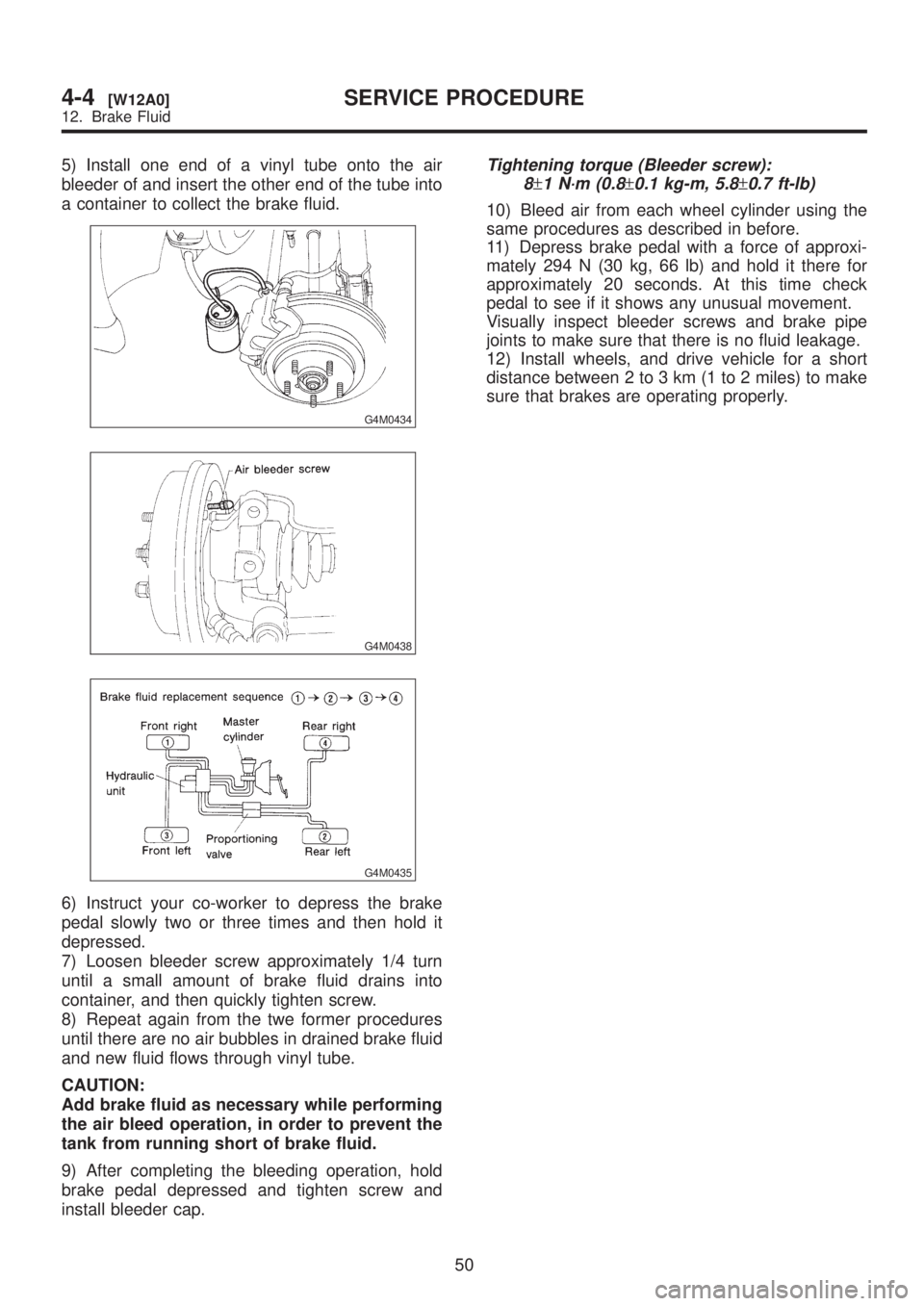
5) Install one end of a vinyl tube onto the air
bleeder of and insert the other end of the tube into
a container to collect the brake fluid.
G4M0434
G4M0438
G4M0435
6) Instruct your co-worker to depress the brake
pedal slowly two or three times and then hold it
depressed.
7) Loosen bleeder screw approximately 1/4 turn
until a small amount of brake fluid drains into
container, and then quickly tighten screw.
8) Repeat again from the twe former procedures
until there are no air bubbles in drained brake fluid
and new fluid flows through vinyl tube.
CAUTION:
Add brake fluid as necessary while performing
the air bleed operation, in order to prevent the
tank from running short of brake fluid.
9) After completing the bleeding operation, hold
brake pedal depressed and tighten screw and
install bleeder cap.
Tightening torque (Bleeder screw):
8
±1 N´m (0.8±0.1 kg-m, 5.8±0.7 ft-lb)
10) Bleed air from each wheel cylinder using the
same procedures as described in before.
11) Depress brake pedal with a force of approxi-
mately 294 N (30 kg, 66 lb) and hold it there for
approximately 20 seconds. At this time check
pedal to see if it shows any unusual movement.
Visually inspect bleeder screws and brake pipe
joints to make sure that there is no fluid leakage.
12) Install wheels, and drive vehicle for a short
distance between 2 to 3 km (1 to 2 miles) to make
sure that brakes are operating properly.
50
4-4[W12A0]SERVICE PROCEDURE
12. Brake Fluid
Page 928 of 1456
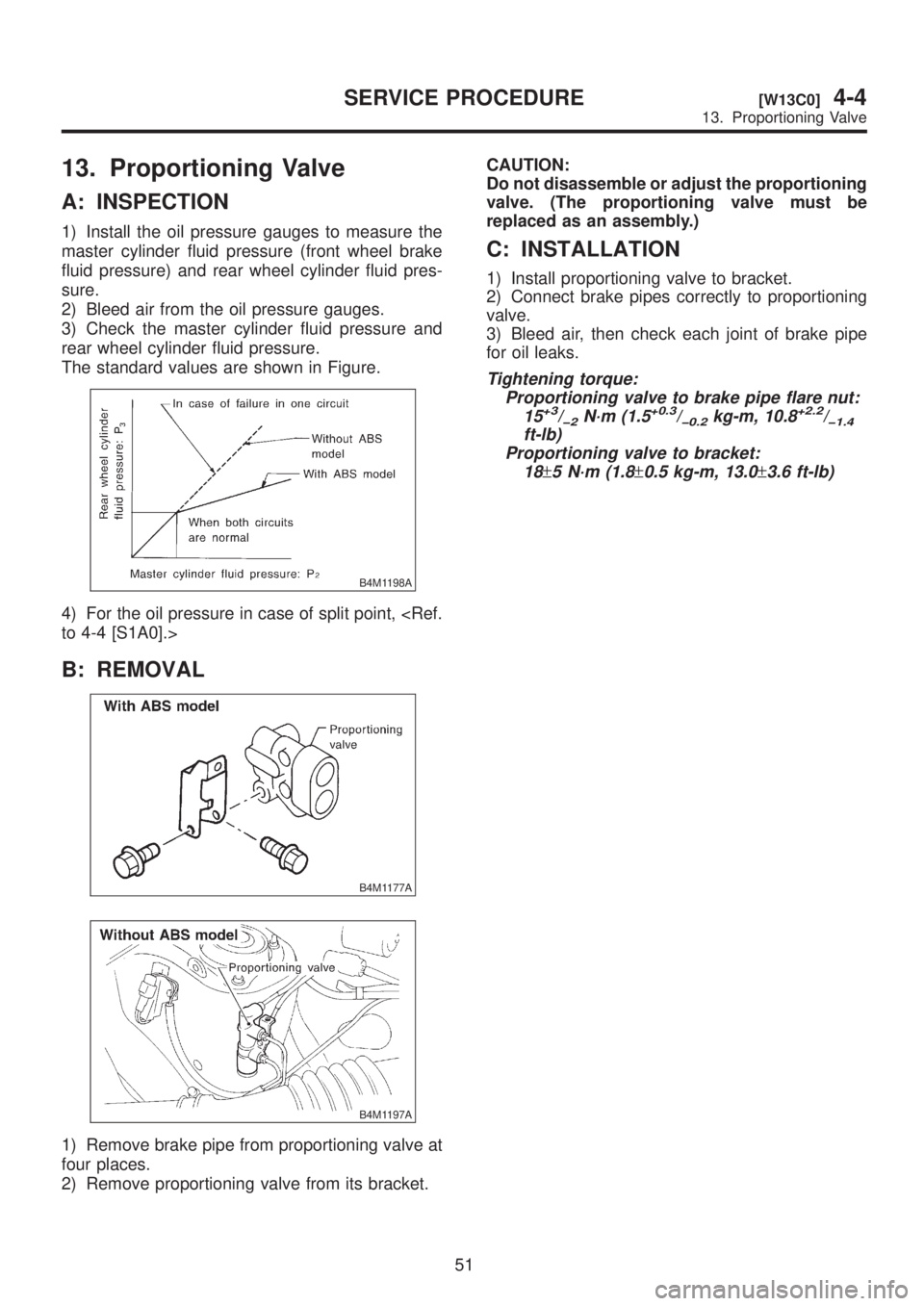
13. Proportioning Valve
A: INSPECTION
1) Install the oil pressure gauges to measure the
master cylinder fluid pressure (front wheel brake
fluid pressure) and rear wheel cylinder fluid pres-
sure.
2) Bleed air from the oil pressure gauges.
3) Check the master cylinder fluid pressure and
rear wheel cylinder fluid pressure.
The standard values are shown in Figure.
B4M1198A
4) For the oil pressure in case of split point,
B: REMOVAL
B4M1177A
B4M1197A
1) Remove brake pipe from proportioning valve at
four places.
2) Remove proportioning valve from its bracket.CAUTION:
Do not disassemble or adjust the proportioning
valve. (The proportioning valve must be
replaced as an assembly.)
C: INSTALLATION
1) Install proportioning valve to bracket.
2) Connect brake pipes correctly to proportioning
valve.
3) Bleed air, then check each joint of brake pipe
for oil leaks.
Tightening torque:
Proportioning valve to brake pipe flare nut:
15
+3/þ2N´m (1.5+0.3/þ0.2kg-m, 10.8+2.2/þ1.4ft-lb)
Proportioning valve to bracket:
18
±5 N´m (1.8±0.5 kg-m, 13.0±3.6 ft-lb)
51
[W13C0]4-4SERVICE PROCEDURE
13. Proportioning Valve
Page 931 of 1456

4) Install front ABS sensor on strut and wheel
apron bracket.
Tightening torque:
32
±10 N´m (3.3±1.0 kg-m, 24±7 ft-lb)
B4M1181A
5) Place a thickness gauge between ABS sensor's
pole piece and tone wheel's tooth face. After stan-
dard clearance is obtained over the entire
perimeter, tighten ABS sensor on housing to speci-
fied torque.
ABS sensor standard clearance:
0.9 Ð 1.4 mm (0.035 Ð 0.055 in)
Tightening torque:
32
±10 N´m (3.3±1.0 kg-m, 24±7 ft-lb)
CAUTION:
Check the marks on the harness to make sure
that no distortion exists. (RH: white, LH: yel-
low)
NOTE:
If the clearance is outside specifications, readjust.
2. REAR ABS SENSOR
1) Install rear tone wheel on hub, then rear hous-
ing on hub.
2) Temporarily install rear ABS sensor on back
plate.
CAUTION:
Be careful not to strike ABS sensor's pole
piece and tone wheel's teeth against adjacent
metal parts during installation.
B4M1182A
3) Install rear drive shaft to rear housing and rear
differential spindle.
Tightening torque:
32
±10 N´m (3.3±1.0 kg-m, 24±7 ft-lb)
G4M0453
5) Place a thickness gauge between ABS sensor's
pole piece and tone wheel's tooth face. After stan-
dard clearance is obtained over the entire
perimeter, tighten ABS sensor on back plate to
specified torque.
ABS sensor standard clearance:
0.7 Ð 1.2 mm (0.028 Ð 0.047 in)
Tightening torque:
32
±10 N´m (3.3±1.0 kg-m, 24±7 ft-lb)
CAUTION:
Check the marks on the harness to make sure
that no distortion exists. (RH: white, LH: yel-
low)
NOTE:
If the clearance is outside specifications, readjust.
54
4-4[W14C2]SERVICE PROCEDURE
14. ABS Sensor
Page 941 of 1456

4) Install front ABS sensor on strut and wheel
apron bracket.
Tightening torque:
32
±10 N´m (3.3±1.0 kg-m, 24±7 ft-lb)
B4M1442A
5) Place a thickness gauge between ABS sensor's
pole piece and tone wheel's tooth face. After stan-
dard clearance is obtained over the entire
perimeter, tighten ABS sensor on housing to speci-
fied torque.
ABS sensor standard clearance:
0.9 Ð 1.4 mm (0.035 Ð 0.055 in)
Tightening torque:
32
±10 N´m (3.3±1.0 kg-m, 24±7 ft-lb)
CAUTION:
Check the marks on the harness to make sure
that no distortion exists. (RH: white, LH: yel-
low)
NOTE:
If the clearance is outside specifications, readjust.
17. Brake Pipe
A: SUPPLEMENTAL RESTRAINT
SYSTEM ªAIRBAGº
Airbag system wiring harness is routed near the
center brake pipe.
CAUTION:
IAll Airbag system wiring harness and con-
nectors are colored yellow. Do not use electri-
cal test equipment on these circuit.
IBe careful not to damage Airbag system wir-
ing harness when servicing the center brake
pipe.
B: REMOVAL AND INSTALLATION
CAUTION:
IWhen removing and installing the brake
pipe, make sure that it is not bent.
IAfter installing the brake pipe and hose,
bleed the air.
IAfter installing the brake hose, make sure
that it does not touch the tire or suspension
assembly, etc.
Brake pipe tightening torque:
15+3/þ2N´m (1.5+0.3/þ0.2kg-m, 10.8+2.2/þ1.4ft-lb)
63
[W17B0]4-4SERVICE PROCEDURE
17. Brake Pipe
Page 942 of 1456

4) Install front ABS sensor on strut and wheel
apron bracket.
Tightening torque:
32
±10 N´m (3.3±1.0 kg-m, 24±7 ft-lb)
B4M1442A
5) Place a thickness gauge between ABS sensor's
pole piece and tone wheel's tooth face. After stan-
dard clearance is obtained over the entire
perimeter, tighten ABS sensor on housing to speci-
fied torque.
ABS sensor standard clearance:
0.9 Ð 1.4 mm (0.035 Ð 0.055 in)
Tightening torque:
32
±10 N´m (3.3±1.0 kg-m, 24±7 ft-lb)
CAUTION:
Check the marks on the harness to make sure
that no distortion exists. (RH: white, LH: yel-
low)
NOTE:
If the clearance is outside specifications, readjust.
17. Brake Pipe
A: SUPPLEMENTAL RESTRAINT
SYSTEM ªAIRBAGº
Airbag system wiring harness is routed near the
center brake pipe.
CAUTION:
IAll Airbag system wiring harness and con-
nectors are colored yellow. Do not use electri-
cal test equipment on these circuit.
IBe careful not to damage Airbag system wir-
ing harness when servicing the center brake
pipe.
B: REMOVAL AND INSTALLATION
CAUTION:
IWhen removing and installing the brake
pipe, make sure that it is not bent.
IAfter installing the brake pipe and hose,
bleed the air.
IAfter installing the brake hose, make sure
that it does not touch the tire or suspension
assembly, etc.
Brake pipe tightening torque:
15+3/þ2N´m (1.5+0.3/þ0.2kg-m, 10.8+2.2/þ1.4ft-lb)
63
[W17B0]4-4SERVICE PROCEDURE
17. Brake Pipe
Page 943 of 1456
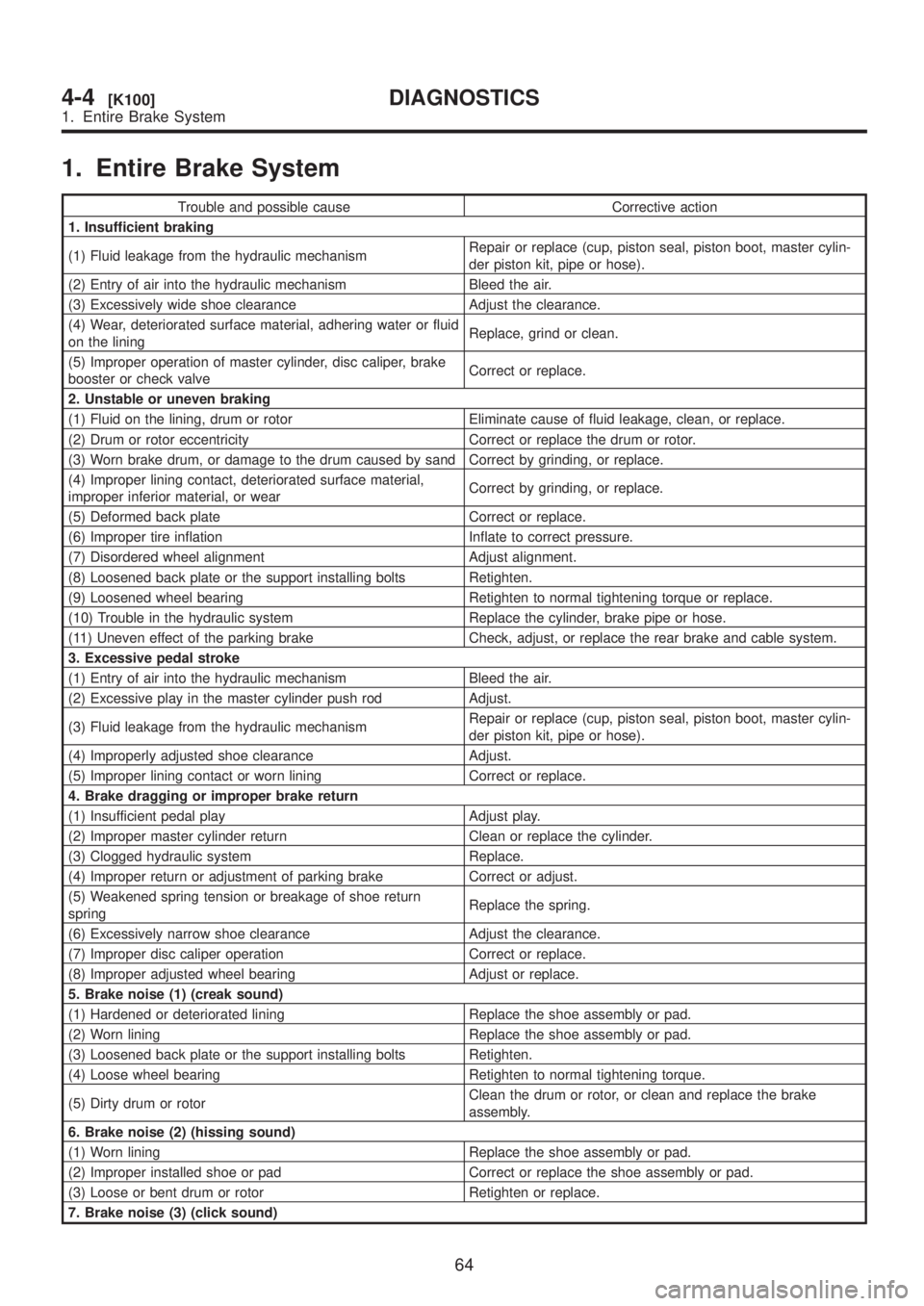
1. Entire Brake System
Trouble and possible cause Corrective action
1. Insufficient braking
(1) Fluid leakage from the hydraulic mechanismRepair or replace (cup, piston seal, piston boot, master cylin-
der piston kit, pipe or hose).
(2) Entry of air into the hydraulic mechanism Bleed the air.
(3) Excessively wide shoe clearance Adjust the clearance.
(4) Wear, deteriorated surface material, adhering water or fluid
on the liningReplace, grind or clean.
(5) Improper operation of master cylinder, disc caliper, brake
booster or check valveCorrect or replace.
2. Unstable or uneven braking
(1) Fluid on the lining, drum or rotor Eliminate cause of fluid leakage, clean, or replace.
(2) Drum or rotor eccentricity Correct or replace the drum or rotor.
(3) Worn brake drum, or damage to the drum caused by sand Correct by grinding, or replace.
(4) Improper lining contact, deteriorated surface material,
improper inferior material, or wearCorrect by grinding, or replace.
(5) Deformed back plate Correct or replace.
(6) Improper tire inflation Inflate to correct pressure.
(7) Disordered wheel alignment Adjust alignment.
(8) Loosened back plate or the support installing bolts Retighten.
(9) Loosened wheel bearing Retighten to normal tightening torque or replace.
(10) Trouble in the hydraulic system Replace the cylinder, brake pipe or hose.
(11) Uneven effect of the parking brake Check, adjust, or replace the rear brake and cable system.
3. Excessive pedal stroke
(1) Entry of air into the hydraulic mechanism Bleed the air.
(2) Excessive play in the master cylinder push rod Adjust.
(3) Fluid leakage from the hydraulic mechanismRepair or replace (cup, piston seal, piston boot, master cylin-
der piston kit, pipe or hose).
(4) Improperly adjusted shoe clearance Adjust.
(5) Improper lining contact or worn lining Correct or replace.
4. Brake dragging or improper brake return
(1) Insufficient pedal play Adjust play.
(2) Improper master cylinder return Clean or replace the cylinder.
(3) Clogged hydraulic system Replace.
(4) Improper return or adjustment of parking brake Correct or adjust.
(5) Weakened spring tension or breakage of shoe return
springReplace the spring.
(6) Excessively narrow shoe clearance Adjust the clearance.
(7) Improper disc caliper operation Correct or replace.
(8) Improper adjusted wheel bearing Adjust or replace.
5. Brake noise (1) (creak sound)
(1) Hardened or deteriorated lining Replace the shoe assembly or pad.
(2) Worn lining Replace the shoe assembly or pad.
(3) Loosened back plate or the support installing bolts Retighten.
(4) Loose wheel bearing Retighten to normal tightening torque.
(5) Dirty drum or rotorClean the drum or rotor, or clean and replace the brake
assembly.
6. Brake noise (2) (hissing sound)
(1) Worn lining Replace the shoe assembly or pad.
(2) Improper installed shoe or pad Correct or replace the shoe assembly or pad.
(3) Loose or bent drum or rotor Retighten or replace.
7. Brake noise (3) (click sound)
64
4-4[K100]DIAGNOSTICS
1. Entire Brake System